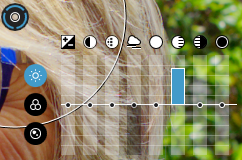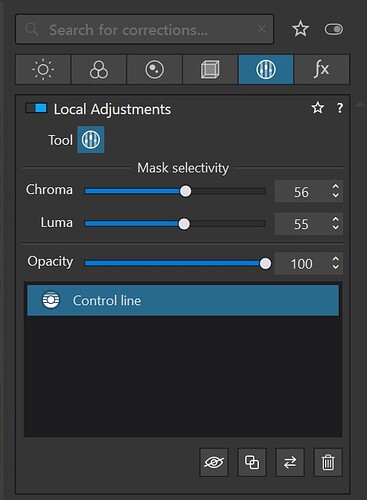As I have said before (sorry, John but I can’t stop myself) it is supremely arse-about-face to have the increments start big and change to smaller ones on the drag to the side. Who starts his car in top gear?!! By the time you have the finer control you’re 1000k out and you don’t have enough screen space to drag back to more or less where you were so you can make your 25k adjustment.
I can only guess that the reason the development crew aren’t wise to this is that they use Macs or don’t use this feature (maybe because it’s too frustrating?!)
@JoJu The problem that it is very frustrating to make subtle adjustments to warmth, tint and hue using the mouse on the sliders.
I see. On the Wacom tablet there’s a “precision mode”, after pushing a button on the tablet, I need 5× more way with the pen. So basically a “sort of smart” loupe function would be good?
I just measured the length of the horizontal slider ways on the palettes. They are not longer than the one of the control points. Capture One let me widen the palettes and then the sliders get 3 × longer (and therefore finer) than PL’s. Even if the palette is as small as I can compress it, ist’s still ⅓ longer than PL’s.
Even if I put my mouse in sniper mode the warmth slider jumps is about 160k increments. I figure that if they can engineer that thing of pulling out to the side to get finer increments then they could do the more obvious thing of starting instead with finer increments and pulling out for some acceleration.
The Mac version doesn’t have the “sideways precision” feature but we do have the ability to use the up/down arrow keys to increment or decrement, which can be helpful on “short range” sliders.
However, on the Colour Temperature slider, starting at 2000° and clicking up gives increments of 32° to start with, but starting at 50,000° and clicking down gives decrements of 892, 882, 874, 864, etc. So its obviously based on a percentage rather than a set interval.
So, it seems like both Windows and Mac could do with a major rework, but will the avid equaliser fans ever be happy if that rework puts the sliders in the sidebar, where it should be so much easier to cope with precise changes?
Cool, didn’t know that. Much better like this, than using the mouse. 
Just being able to move it around, would be fine.
Completely agree!!
I’ll probably be okay with the sliders in the sidebar if I can control them with my keyboard. I certainly don’t want to be pulling my mouse, and my eyes, all the way over to my second screen for every control point adjustment!
I know that about the Mac users being able to use the keyboard for precise increments. I’m very jealous!
Let me change the emphasis of that:
I really would totally hate it if I had to pull my mouse, and my eyes, all the way over to my second screen for every control point adjustment. However, I might very much like it to have the sliders on the side IF I could navigate and adjust them in reasonable increments, using my arrow keys.
As long as it’s clear if I’m in the whole image doing my adjustments or on any of my masks, I would don’t complain. I’m, used to Capture One’s “layers” (actually, they don’t have as many layer modes like PS or AP, but I don’t expect a RAW converter to become a super versatile photo-editor).
C1 has the layers very well visible on top of the exposure palette.
Why not put the local adjustments Equaliser in a floating palette that can be moved to any position on the screen. This would satisfy everyone as you could put it wherever you like.
Additionally, you could make it very similar to the standard palettes with the Colour Group, Light Group and Detail Group as switches at the top of the palette.
That is certainly an excellent idea but it could not remain as an equaliser if it is going to be able to cope with the increasing demand for palettes like the Colour Wheel and others to be available for local adjustments.
And, seeing that other palettes can all be either fixed or floating, it might as well follow the same pattern - floating being a simple matter of dragging it from the sidebar if required.
Lightroom has a separate LA palette with duplicated sliders, which makes it easy to distinguish GA and LA actions.
Maybe I’ve missed it , but have you tried pulling your mouse to the right or left of the slider after you click on it? The farther away you pull it to the right or left, the greater the granularity of the resulting movement of your mouse as you move it up and down. The smallest temperature change I can control this way is 2K. This trick also works to increase granularity for all the local adjustment sliders in the Windows version,.
Mark
It works for me on Win PL5. The mouse cursor does have to be right over the adjustment point for the up/down arrow keys to work.
mouse cursor does have to be right over the adjustment point for the up/down arrow keys to work
Are you referring to these sliders, jch ? 
… where do you position your mouse cursor ?
John
Aah! I was thinking of the Local Adjustments pallet,
where it does work. My misunderstanding. No, you’re right, the arrow keys don’t work in the Local Adjustments Equalizer. And for consistency they certainly should…
Thanks, but actually you have missed the numerous times I’ve mentioned that and criticised it, including here in this thread, not to mention that it is implied in the comment you are responding to. 
 Again: “… it is supremely arse-about-face to have the increments start big and change to smaller ones on the drag to the side. Who starts his car in top gear?!! By the time you have the finer control you’re 1000k out and you don’t have enough screen space to drag back to more or less where you were so you can make your 25k adjustment.”
Again: “… it is supremely arse-about-face to have the increments start big and change to smaller ones on the drag to the side. Who starts his car in top gear?!! By the time you have the finer control you’re 1000k out and you don’t have enough screen space to drag back to more or less where you were so you can make your 25k adjustment.”
If you are able to start at, say, 5200K and drag across and still find you mouse within a 500k range of that by the time you get low gear then I have to admit that your mouse skills are Olympic gold medal standard!
But even if I could do it, I’d still consider it bafflingly back-to-front. I start my car in first gear and as I accelerate I change up a gear. That is the common-sense orthography.
I like your idea of changing the sensitivity of the sliders from slow to fast as you move further away. I have struggled in the past and specially for colour temp and tint.
